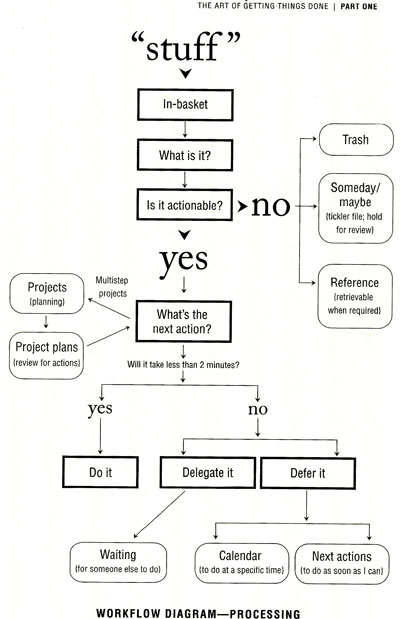Productivity improvement techniques- Getting things done!
Some people just manage getting stuff in very little time! I wanted to become one of those guys,
 so I read “Getting
so I read “Getting
things done” by David Allen. After only a week, it has already changed my life!
I’m therefore going to summarize quickly the book and give you the main structure to some of the impressive productivity improvement techniques I learned in the book!
You productivity is your ability to stay purely focused on one single task at the time and keep your mind free of the stuff you have to do. So how do you do this?
1) Get stuff out of your mind- Every time you have stuff on your mind, write it down. Your mind needs to stay clean!
Maybe the main reason we quickly get exhausted during the day is because we carry too many thoughts at the same time! There is too much mess in your mind.
The first secret to removing the mess is to write down everything you have on your mind! Write down everything! Next step is putting all your thoughts into systems.
2) Decide what to do
First ask yourself, what is it?
- Is it an article you want to read. Is it a movie you want to watch? Is it someone I have to call?
- Is it just an idea?
- Is it a project (something that requires more than one step to finish)
Is it something actionable? Something you need to get done soon? When the answer is NO , then:
- When you don’t need it at all, it’s trash (delete it from your list and your head!)
-
If it is a project or an action, you don’t need to get done soon, “incubate it”. I store in my “
maybe/ someday
” list. It’s a list of stuff you would like to get done in the future (such as Learning Chinese, learn to fly fish, learn kitesurfing, call Ivan).

- If it is reference material (such as nice articles, brochures, Youtube videos) that you want to keep, store them in folders called “ reference files ”.
I have all in my computer, so I store everything in folders, bookmarks and Google Drive docs as seen in the picture above.
If the answer is YES : When something takes less than 2 minutes to get done, then do it right away. For anything else, it needs a bit of planning.
3) Plan your projects and next actions
Stuff that you need to do are either stuff you can finish in one step or projects . Projects are stuff that require more than one step to be achieved. Examples are planning weddings, conferences, recruiting someone. Something that just require one action step is stuff like creating a blog post or reserving a restaurant.
If it is a project:
-
Write down all your projects on one list (I use Google docs).

-
Then in a separate sheet, define all the necessary steps to achieve to finish your projects.

For stuff that aren’t projects, you’ll put it directly into the system we’ll see know.
4) Get organized with a calendar and a “Next Action” list
Your daily organization consists of at least these two categories:
- Stuff that go to your Calendar and that has to happen on a specific time or day
- Things that go to your Next Action list are stuff you want to get done soon!
The Calendar is your main priority as it is time-specific stuff. It includes:
- Appointments
- Day specific actions: Things you need to get done during a certain day (maybe you said you’d call your accountant on a specific day)
- Day specific information: things that need to be known on specific days. E.g the weekly project update.
There should be no to-do list on your calendar: Constant reminders about what you need to do drains energy from the stuff you have to do in the moment. Also, as stuff always change, you’ll spend time be stressed while re-configuring this list.
The next action list is the heart of the daily action management. It’s a list of all things that has to be done soon. This list, for most professionals, comprises 50-200 things. If the case, it’s best to subdivide your next- action stuff into categories. I organize them in context; this is how:
Sometimes there are things you can’t do yourself. It’s stuff others have to do for you. These things, you put in a specific “waiting for” list.

5) Review and get organized
It is easy to write down that you have to buy eggs, bacon, and toilet paper. You, therefore, need to review your lists enough that you always have a clear overview of the stuff you need to do and when!
- Your calendar is naturally the thing you should look at the most as it includes the stuff your road-map of the stuff you just need to get done!
- Your next action list is the stuff you can do if your calendar allows you to! I organize them into context, so that play in the contexts are available. Every time I go shopping, I check my Shopping/ Grocery list.
- A least once a week, you need to review your “ projects ”, “ later/ someday ” and “ waiting for ”. The rule is to review these lists as often in order for you to stop wondering about them!
The weekly review helps you clean your mind by updating your lists. It’s where you get a complete overview of your life to feel clean.
When you apply these steps, you’ll naturally have an overview of all the stuff you want to get done. And you’ll naturally know how to proceed, prioritize stuff and take decisions!
This is a short resume of the book. If you want to go more in detail, I naturally recommend reading the book. Here is a graphical illustration of the process:
Liked this article? Then subscribe to our newsletter and get the more productivity tips!









Leave A Comment